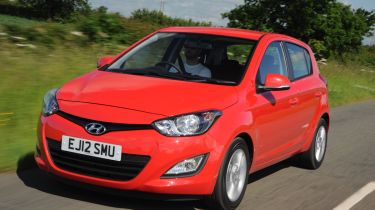Hyundai i20
Mid-life update aims to make supermini more desirable
The Hyundai i20 was one of the stars of the Scrappage Scheme, between May 2009 and April 2010, and has been a big sales hit in the UK. But while the old model offered a worthy mixture of practicality and value for money, it never really captured buyers’ imaginations the way the best small cars can.
To address this image problem, Hyundai has given its supermini a mid-life makeover that includes a full cosmetic facelift and some subtle tweaks to the engine and gearbox. The biggest styling changes have all been made at the front, where the brand’s trademark hexagonal grille and intricate new headlight design make the i20 look more grown-up.
Top-spec Style models get a gaudy set of LED running lights in the foglight clusters, while 1.4-litre diesel and petrol versions benefit from 16-inch alloys. Our 1.2-litre model has to make do with 15-inch wheels, and it looks slightly anonymous as a result.
At the back, the bumpers have been mildly reshaped, but overall the design looks a little busy compared to the simpler Suzuki, and it lacks the impact of cars like the Peugeot 208.
Changes aren’t quite as obvious inside. The centre console has been smartened up with some piano-black inserts around the stereo and climate control dials, but the slim trip computer integrated into the top of the dashboard already looks dated. There are some neat touches, such as a small cubby above the gearlever that’s perfect for hiding your phone in. Plus, there are steering wheel- mounted Bluetooth and audio controls.
Used - available now
However, some trim feels flimsy compared to that in the Suzuki, and things like the fake chrome gearknob and indicators aren’t as well built as they are in newer Hyundais. Also, the front seats are short on lateral support and the driver is seated too high. Although this gives a good view, it also makes you feel like you’re sat on top of the i20, not inside it.
These gripes aside, there’s no denying that the car provides more space and standard kit than almost all of its major competitors. The mid-level Active model in our pictures has front foglights, Bluetooth and all-round electric windows, but the Style version we tested adds luxuries like climate control, auto headlights, rain-sensing wipers and even a reversing camera in the mirror.
All these extras make the i20 easy to live with every day, and the amount of interior space on offer also helps strengthen its case. The Hyundai can carry nearly twice as much luggage as the Swift with the back seats down. It also has more head and legroom in the back – even though the i20’s roof is 20mm lower.
Niggles remain, though. For example, you can’t fit a water bottle into the door pockets and unlike in the Swift, there’s no dash-top storage. Still, practicality was always one of the i20’s strengths, so it’s more important to find out if the facelifted car is better to drive.
Initial signs are good, as Hyundai has tweaked the most popular 1.2-litre petrol engine to produce slightly more power and reduce its CO2 emissions from 119g/km to 114g/km. Yet it lags behind the Suzuki on the road. Throttle response is slow, and once the revs do start to climb, it sounds rough and intrusive. This lack of urgency was shown at the track where the i20 trailed the Swift in all our timed acceleration tests.
The five-speed manual gearbox has also been revised – supposedly to European tastes – but it still feels notchy and loose compared to the Swift’s. The same problem affects the steering, which is light enough for town use but weights up inconsistently in corners and lacks feel.
None of this is crucial to supermini buyers, but the bouncy and overly soft ride, plus a lack of cruising refinement, will put off those wanting their i20 for long journeys.
Like all Hyundais, it boasts a five-year warranty, which the Suzuki can’t match. Yet 35.7mpg economy and poor residuals raise questions over costs. So can the revised i20 triumph over the small but talented Swift?
Details
Chart position: 2Why? Revised i20 gets the latest family look. Style model has kit like a reversing camera and auto lights. Five-year warranty and low price mean it’s good value, too.











